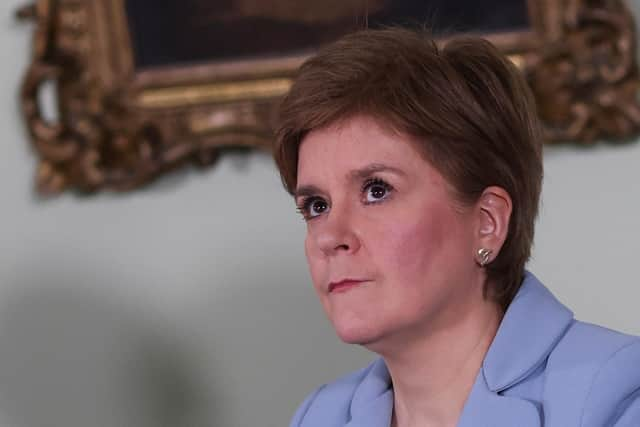Scottish independence: What have we learned and what big questions remain unanswered?
The First Minister launched the new document at Bute House, her official residence in Edinburgh, on Tuesday morning.
She was flanked by Patrick Harvie, the co-leader of the Greens, who is also a Scottish Government minister.
Advertisement
Hide AdAdvertisement
Hide AdThe pair took questions from journalists for more than an hour. But what did we learn and what key questions remain unanswered?


What the new document says
The first in a series of documents, the paper published on Tuesday was described as a “scene-setter” and runs to around 70 pages. It sets out an analysis of the UK’s performance across a range of economic and social indicators, and compares this to ten “comparator countries”. These are Denmark, Sweden, Finland, Norway, Iceland, Ireland, Switzerland, Austria, Belgium and the Netherlands. The paper finds these countries “frequently outperform” the UK. They are wealthier, income inequality is lower, poverty rates are lower, there are fewer children living in poverty, productivity is higher and business investment tends to be higher. Essentially, the document argues countries of a similar size are “achieving better outcomes” than Scotland as part of the UK, and suggests the “full powers of independence” are necessary to emulate this.
What documents are still to come
Ms Sturgeon said future papers will tackle thorny issues such as currency, Scotland’s fiscal position, pensions and social security, EU membership and trade, and defence and security. “In these papers we will set out how Scotland can benefit from the massive opportunities that independence will present,” she said. She pledged to “confront openly the challenges” and insisted: “We will not shy away from tough questions.” The precise order and publication dates for these papers has yet to be decided, but they will be released “fairly steadily” over coming months. It’s fair to say these future documents will be a lot more contentious than the initial “scene-setter”. The tough issues Ms Sturgeon has vowed to confront include extremely difficult, emotive issues such as the border between Scotland and England.
‘Issues’ with Scotland-England border – and other problems
Ms Sturgeon said one of the coming papers will “confront the implications of Brexit”, including what it means for the border between Scotland and England in the event of independence. Notably, the First Minister admitted the Scottish Government will have to confront “regulatory and customs issues around goods”. This is a reference to the checks that would surely be necessary if an independent Scotland joined the EU while the rest of the UK remained outside of it. It is one of the key issues facing independence campaigners, and the well-documented problems in Northern Ireland show how complicated this can get. But it is just one of many areas that will need to be addressed head-on. Big questions remain unanswered on currency, pensions, Scotland’s fiscal position, defence and security. The SNP was seen as weak on the currency issue in 2014. It won’t want to repeat that mistake.
Nicola Sturgeon to update Holyrood on ‘lawful’ plans for indyref2
Ms Sturgeon said she intends to deliver on her “mandate” for a second referendum, but insisted it “must be lawful”. Prime Minister Boris Johnson has repeatedly said he will not transfer the power to hold a referendum to Scotland through a section 30 order, as happened in 2014. Ms Sturgeon said she “stands ready to discuss the terms of such an order at any time”, but the First Minister does not appear to have formally asked Mr Johnson again. She said the UK Government has “no respect for democracy”, and so Scottish ministers “must forge a way forward, if necessary, without a section 30 order”. Ms Sturgeon added: “We know that in these circumstances the competence of the Scottish Parliament to legislate is contested, and that therefore is the situation we must navigate to give people the choice of independence.” That work is “well underway”, she insisted, and a “significant update” to Parliament will happen “very soon”. This is expected in the next couple of weeks, before Holyrood breaks for the summer.
But how can indyref2 take place if Westminster says No?
This is one of the biggest unanswered questions. Ms Sturgeon said work is “well underway” on forging a way forward without a section 30 order, but it is not at all clear how this could feasibly happen. Under the Scotland Act 1998, the union is reserved to Westminster. There are different legal opinions on how this might affect any referendum legislation. It’s not clear what legal advice the Scottish Government has received on the matter. It could introduce legislation under the expectation it will be challenged in the Supreme Court, but what happens if the court rules against it? Is that the end of the road? And would unionists take part in a referendum that is taking place without Westminster’s consent? Things could get very messy indeed.
When will indyref2 legislation be introduced?
Again, we don’t know, although we can assume Ms Sturgeon’s statement to Holyrood in the next couple of weeks will shed some light on this area. There is an expectation it could be introduced after the summer break. It will be a big moment for the Scottish Government and, as outlined above, could lead to a dramatic court battle. The legislation itself will be heavily scrutinised.
Comments
Want to join the conversation? Please or to comment on this article.
